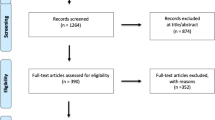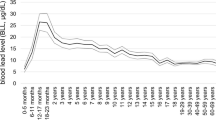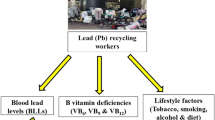Abstract
We evaluated the effect of lead (Pb) abatement measures in Croatia on blood lead (BPb) concentrations, and delta-aminolevulinic acid dehydratase (ALAD) activity in blood, as a sensitive indicator of early Pb effect. Data on BPb and ALAD activity were obtained from 829 Croatian men (19–64 years of age), with no known occupational exposure to metals. Data obtained in 2008–2009, after the ban of leaded gasoline in Croatia in 2006, were compared with similar data collected in 1981 and 1989, when the concentration of Pb in gasoline was 0.6 g/L. Our results showed a highly significant (p < 0.001) decrease in median BPb from 114.5 (range, 46.0–275.0) μg/L in 1981/1989 to 30.3 (range, 3.2–140.8) μg/L in 2008–2009 and an increase in median ALAD activity from 49.8 (range, 24.9–79.4) EU in 1981/1989 to 60.9 (range, 35.8–84.0) EU in 2008–2009. Individual factors influencing BPb values were, in the order of decreasing importance, Pb in ambient air (APb), alcohol consumption, age, and smoking. Increased ALAD activity was significantly associated with the decrease of APb, alcohol consumption, and smoking. These results show that lead abatement measures had a positive impact on both BPb concentrations (73.5 % decrease) and the activity of ALAD (22.1 % increase) in general population. Our results contribute to growing evidence that ALAD activity may be used as one of the earliest and sensitive diagnostic biomarkers of low-level Pb exposure.


Similar content being viewed by others
References
Ahamed M, Verma S, Kumar A, Siddiqui MKJ (2006) Delta-aminolevulinic acid dehydratase inhibition and oxidative stress in relation to blood lead among urban adolescents. Hum Exp Toxicol 25:547–553
Arnetz BB, Nicolich MJ (1990) Modelling of environmental lead contributors to blood lead in humans. Int Arch Occ Environ Heal 62:397–402
ATSDR (2007) Toxicological Profile for Lead. U.S. Department of Health and Human Services. Public Health Service. Agency for Toxic Substances and Disease Registry, p. 528
Barbosa F, Tanus-Santos JE, Gerlach RF, Parsons PJ (2005) A critical review of biomarkers used for monitoring human exposure to lead: advantages, limitations, and future needs. Environ Health Persp 113:1669–1674
Becker K, Schroeter-Kermani C, Seiwert M, Rüther M, Conrad A, Schulz C, Wilhelm M, Wittsiepe J, Günsel A, Dobler L, Kolossa-Gehring M (2013) German health-related environmental monitoring: assessing time trends of the general population’s exposure to heavy metals. Int J Hyg Environ Health 216:250–254
Berlin A, Schaller KH (1974) European standardized method for determination of delta-aminolevulinic-acid dehydratase activity in blood. Zeitschrift Fur Klinische Chemie Und Klinische Biochemie 12:389–390
Bierkens J, Smolders R, Van Holderbeke M, Cornelis C (2011) Predicting blood lead levels from current and past environmental data in Europe. Sci Total Environ 409:5101–5110
Blanuša M, Telišman S, Hršak J, Fugaš M, Prpić-Majić D, Šarić M (1991) Assessment of exposure to lead and cadmium through air and food in inhabitants of Zagreb. Arh Hig Rada Toksikol 42:257–266
Bono R, Pignata C, Scursatone E, Rovere R, Natale P, Gilli G (1995) Updating about reductions of air and blood lead concentrations in Turin, Italy, following reductions in the lead content of gasoline. Environ Res 70:30–34
Brody DJ, Pirkle JL, Kramer RA, Flegal KM, Matte TD, Gunter EW, Paschal DC (1994) Blood lead levels in the US population—phase 1 of the 3rd National Health And Nutrition Examination Survey (NHANES-III, 1988 to 1991). JAMA 272:277–283
CDC (Centers for Disease Control and Prevention) (1991) Preventing lead poisoning in young children (U.S.). US Department of Health and Human Services, Atlanta, GA
CEA (Croatian Environment Agency) (2011) Air pollutant emissions in the Republic of Croatia for 2009. Croatian Environment Agency, Zagreb (in Croatian)
Chisolm JJ Jr (1971) Lead poisoning. Sci Am 224:15–23
Cook RD (1977) Detection of influential observations in linear regression. Technometrics 19:15–18
Ducoffre G, Claeys F, Bruaux P (1990) Lowering time trend of blood lead levels in Belgium since 1978. Environ Res 51:25–34
Elwood PC (1983) Changes in blood lead concentrations in women in Wales 1972–82. Br Med J 286:1553–1555
Engstrom KS, Stromberg U, Lundh T, Johansson I, Vessby B, Hallmans G, Skerfving S, Broberg K (2008) Genetic variation in glutathione-related genes and body burden of methylmercury. Environ Health Perspect 116:734–739
ENHIS (2009) Levels of lead in children's blood. Fact sheet 4.5. World Health Organisation, Europe. http://www.eomsociety.org/attachments/4.5.-Levels-of-lead-in-childrens-blood-EDITING_layouted.pdf. Accessed 14 May 2014
Falq G, Zeghnoun A, Pascal M, Vernay M, Le Strat Y, Garnier R, Olichon D, Bretin P, Castetbon K, Fréry N (2011) Blood lead levels in the adult population living in France the French Nutrition and Health Survey (ENNS 2006–2007). Environ Int 37:565–571
Goering PL (1993) Lead-protein interactions as a basis for lead toxicity. Neurotoxicology 14:45–60
Granick JL, Sassa S, Granick S, Levere RD, Kappas A (1973) Studies in lead poisoning. 2. Correlation between ratio of activated to inactivated aminolevulinic acid dahydratase of whole blood and blood lead level. Biochem Med 8:149–159
GRC (Government of the Republic of Croatia) (1997) Regulation on quality standards of liquid petroleum fuels. Narodne novine (Official Journal of the Republic of Croatia) 76. http://narodne-novine.nn.hr/. Accessed 14 May 2014 (in Croatian)
GRC (Government of the Republic of Croatia) (2002) Regulation on the quality of liquid fuels. Narodne novine (Official Journal of the Republic of Croatia) 83/1375. http://narodne-novine.nn.hr/. Accessed 14 May 2014 (in Croatian)
GRC (Government of the Republic of Croatia) (2006) Regulation on the quality of liquid fuels. Narodne novine (Official Journal of the Republic of Croatia) 53/1261. http://narodne-novine.nn.hr/. Accessed 14 May 2014 (in Croatian)
Hense H, Filipiak B, Novak L, Stoeppler M (1992) Nonoccupational determinants of blood lead concentrations in a general population. Int J Epidemiol 21:753–762
Hernberg S, Nikkanen J (1970) Enzyme inhibition by lead under normal urban conditions. Lancet 1:63–64
Hernberg S, Nikkanen J, Mellin G, Lilius H (1970) Delta-aminolevulinic acid dehydrase as a measure of lead exposure. Arch Environ Health 21:140–145
Huršidić-Radulović A, Cvitković J (2003) Lead exposure in toll-booth operators. Arh Hig Rada Toksikol 54:133–140
Jones RL, Homa DM, Meyer PA, Brody DJ, Caldwell KL, Pirkle JL, Brown MJ (2009) Trends in blood lead levels and blood lead testing among US children aged 1 to 5 years, 1988–2004. Pediatrics 123:e376–e385
Jurasović J, Telišman S (1993) Determination of lead and cadmium in human seminal fluid by electrothermal atomic absorption spectrometry. J Anal Atom Spectrom 8:419–425
Jurasović J, Cvitković P, Pizent A, Čolak B, Telišman S (2004) Semen quality and reproductive endocrine function with regard to blood cadmium in Croatian male subjects. BioMetals 17:735–743
Kašuba V, Rozgaj R, Milić M, Željezic D, Kopjar N, Pizent A, Kljaković-Gašpić Z, Jazbec A (2012) Evaluation of genotoxic effects of lead in pottery-glaze workers using micronucleus assay, alkaline comet assay and DNA diffusion assay. Int Arch Occ Env Hea 85:807–818
Mathee A, Röllin H, Von Schirnding Y, Levin J, Naik I (2006) Reductions in blood lead levels among school children following the introduction of unleaded petrol in South Africa. Environ Res 100:319–322
Menke A, Muntner P, Batuman V, Silbergeld EK, Guallar E (2006) Blood lead below 0.48 mu mol/L (10 mu g/dL) and mortality among US adults. Circulation 114:1388–1394
Muntner P, Menke A, DeSalvo KB, Rabito FA, Batuman V (2005) Continued decline in blood lead levels among adults in the United States—The National Health and Nutrition Examination Surveys. Arch Intern Med 165:2155–2161
Neo KS, Goh KT, Sam CT (2000) Blood lead levels of a population group not occupationally exposed to lead in Singapore. Southeast Asian J Trop Med Public Health 31(2):295–300
Nordman CH, Hernberg S (1975) Blood lead levels and erythrocyte δ amino levulinic acid dehydratase activity of selected population groups in Helsinki. Scand J Work Environ Heal 1:219–232
Piomelli S, Corash L, Corash MB, Seaman C, Mushak P, Glover B, Padgett R (1980) Blood lead concentrations in a remote Himalayan population. Science 210:1135–1137
Pizent A, Jurasović J, Telišman S (2001) Blood pressure in relation to dietary calcium intake, alcohol consumption, blood lead, and blood cadmium in female nonsmokers. J Trace Elem Med Bio 15:123–130
Pizent A, Jurasović J, Telišman S (2003) Serum calcium, zinc, and copper in relation to biomarkers of lead and cadmium in men. J Trace Elem Med Bio 17:199–205
Pizent A, Macan J, Jurasović J, Varnai VM, Milković-Kraus S, Kanceljak-Macan B (2008) Association of toxic and essential metals with atopy markers and ventilatory lung function in women and men. Sci Total Environ 390:369–376
Roels H, Buchet JP, Lauwerys R, Hubermont G, Bruax P, Claeysthoreau F, Lafontaine A, Vanoverschelde J (1976) Impact of air pollution by lead on heme biosynthetic pathway in school age children. Arch Environ Health 31(6):310–316
Sakai T, Morita Y (1996) Delta-aminolevulinic acid in plasma or whole blood as a sensitive indicator of lead effects, and its relation to the other heme-related parameters. Int Arch Occ Env Hea 68:126–132
Schwartz J, Pitcher H (1989) The relationship between gasoline lead and blood lead in the United States. J Off Stat 5:421–431
Smolders R, Alimonti A, Cerna M, Den Hond E, Kristiansen J, Palkovicova L, Ranft U, Seldén AI, Telišman S, Schoeters G (2010) Availability and comparability of human biomonitoring data across Europe: a case-study on blood-lead levels. Sci Total Environ 408:1437–1445
Stroh E, Lundh T, Oudin A, Skerfving S, Strömberg U (2009) Geographical patterns in blood lead in relation to industrial emissions and traffic in Swedish children, 1978–2007. BMC Public Health 9:225. doi:10.1186/1471-2458-9-225
Stromberg U, Schutz A, Skerfving S (1995) Substantial decrease of blood lead in Swedish children, 1978–94, associated with petrol lead. Occup Environ Med 52:764–769
Stromberg U, Lundh T, Skerfving S (2008) Yearly measurements of blood lead in Swedish children since 1978: the declining trend continues in the petrol-lead-free period 1995–2007. Environ Res 107:332–335
Šarić M, Blanuša M, Fugaš M, Prpić-Majić D, Telišman S (1992) Croatia and Slovenia: lead exposure and lead effects studies, human exposure to lead—Report on the Human Exposure Assessment Location (HEAL) Programme Meeting held in Bangkok, Thailand, 16–19 November 1992. WHO, Geneve, pp 73–87
Telišman S, Keršanc A, Prpić-Majić D (1982) The relevance of arguments for excluding ALAD from the recommended biological limit values in occupational exposure to inorganic lead (WHO 1980). Int Arch Occ Environ Heal 50:397–412
Telišman S, Prpić-Majić D, Kezić S (1984) In vivo study on lead and alcohol interaction and the inhibition of erythrocyte delta-aminolevulinic acid dehydratase in man. Scand J Work Environ Heal 10:239–244
Telišman S, Cvitković P, Jurasović J, Pizent A, Gavella M, Ročić B (2000) Semen quality and reproductive endocrine function in relation to biomarkers of lead, cadmium, zinc, and copper in men. Environ Health Perspect 108:45–53
Telišman S, Jurasović J, Pizent A, Cvitković P (2001) Blood pressure in relation to biomarkers of lead, cadmium, copper, zinc, and selenium in men without occupational exposure to metals. Environ Res 87:57–68
Telišman S, Čolak B, Pizent A, Jurasović J, Cvitković P (2007) Reproductive toxicity of low-level lead exposure in men. Environ Res 105:256–266
Thomas VM, Socolow RH, Fanelli JJ, Spiro TG (1999) Effects of reducing lead in gasoline: an analysis of the international experience. Environ Sci Technol 33:3942–3948
Vađić V, Hršak J, Žužul S (2009) Trends of lead in suspended particulate matter in Zagreb air. Int J Environ Pollut 39:385–391
Vahter M (1982) Assessment of human exposure to lead and cadmium through biological monitoring. In: Vahter M (ed) Global Environmental Monitoring System (GEMS). National Swedish Institute of Environmental Medicine and Department of Environmental Medicine, Karolinska Institute, Stockholm (for UNEP/WHO), p. 136
von Storch H, Hagner C (2004) Controlling lead concentrations in human blood by regulating the use of lead in gasoline. Ambio 33(3):126–132
Wang Q, Zhao HH, Chen JW, Hao QL, Gu KD, Zhu YX, Zhou YK, Ye LX (2010) Delta-aminolevulinic acid dehydratase activity, urinary delta-minolevulinic acid concentration and zinc protoporphyrin level among people with low level of lead exposure. Int J Hyg Environ Heal 213:52–58
Wang Q, Ye LX, Zhao HH, Chen JW, Zhou YK (2011) Benchmark dose approach for low-level lead induced haematogenesis inhibition and associations of childhood inteligences with ALAD activity and ALA levels. Sci Total Environ 109:1806–1810
Watanabe T, Fujita H, Koizumi A, Chiba K, Miyasaka M, Ikeda M (1985) Baseline level of blood lead concentration among Japanese farmers. Arch Environ Health 40:170–176
Wennberg M, Lundh T, Bergdahl IA, Hallmans G, Jansson JH, Stegmayr B, Custodio HM, Skerfving S (2006) Time trends in burdens of cadmium, lead, and mercury in the population of northern Sweden. Environ Res 100:330–338
WHO (1977) Lead, environmental health criteria, 3rd edn. World Health Organisation, Geneva
WHO (1995) Inorganic lead. World Health Organisation, Geneva
Wietlisbach V, Rickenbach M, Berode M, Guillemin M (1995) Time trend and determinants of blood lead levels in a Swiss population over a transition period (1984–1993) from leaded to unleaded gasoline use. Environ Res 68:82–90
Acknowledgments
This research was supported by the Croatian Ministry of Science, Education and Sports of the Republic of Croatia (Project No. 022-0222411-2408). We would like to express our sincere gratitude to Dr. Spomenka Telišman and the late Dr. Danica Prpić-Majić, our former mentors and supervisors, as this work is based on their long-standing research in the area of biological monitoring and health effects of lead in humans. We are also grateful to our former colleague J. Pongračić for her invaluable contribution in blood lead analysis.
Conflict of interest
The authors declare that they have no competing interests.
Ethical standard
All procedures performed in this study involving human participants were in accordance with the ethical standards of institutional ethics committee and with the 1964 Helsinki Declaration and its later amendments or comparable ethical standards.
Author information
Authors and Affiliations
Corresponding author
Additional information
Responsible editor: Philippe Garrigues
Electronic supplementary material
Below is the link to the electronic supplementary material.
ESM 1
Relationship between logarithmically transformed BPb concentrations of 829 male Zagreb citizens with changes in the maximum allowed concentration of lead in gasoline (GPb). The solid line is log10 BPb = 1.4429 + 0.7923 × GPb; r = 0.6432; p < 0.0001. The intercept at GPb = 0 yields a BPb value of 27.73 μg/L (DOCX 62 kb)
Rights and permissions
About this article
Cite this article
Zorana, KG., Alica, P. & Jasna, J. Influence of abatement of lead exposure in Croatia on blood lead and ALAD activity. Environ Sci Pollut Res 23, 898–907 (2016). https://doi.org/10.1007/s11356-015-5338-1
Received:
Accepted:
Published:
Issue Date:
DOI: https://doi.org/10.1007/s11356-015-5338-1




